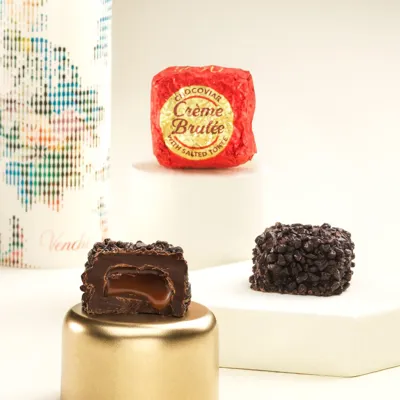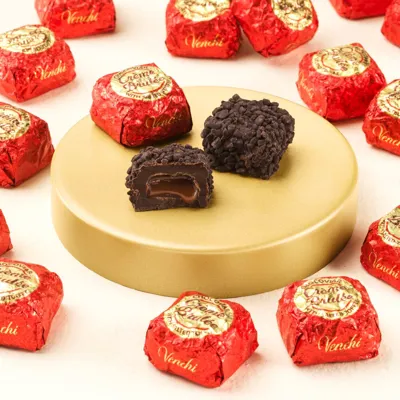Venchi Caramel Chocolate
When and where was caramel invented?
The origins of caramel are somewhat unclear, though some historians link its beginnings to the Arabs around 1000 A.D., who created a hard, sweet treat known as kurat al milh, or “sweet ball of salt,” by boiling sugar.
Caramel later rose to popularity in 19th-century America, where the addition of milk and butter transformed it into the soft, chewy candy we recognise today. In the 1980s, French pastry chef Henri Le Roux invented salted caramel, a rich and balanced variation that has since become a worldwide favourite.
What is caramel, exactly?
You’ve probably tasted caramel in chocolates or as a sweet drizzle on desserts—but what is it, exactly? Caramel is a rich, sticky treat made by slowly heating sugar until it melts and changes colour and flavour. As the sugar heats—usually to about 170°C—it breaks down and creates the deep, slightly nutty flavour that makes caramel so unique. There are a few different ways to make caramel. The simplest kind, known as dry caramel, is made by heating sugar on its own—this can be white or even brown sugar. Another method is called wet caramel, where sugar is melted together with water until the sugar caramelises.
How to describe caramel's flavour against chocolate?
Caramel and chocolate are both beloved sweets, but they’re different in terms of ingredients, preparation, flavour, and texture—even though they’re often combined to create caramel chocolate.
Caramel is a great example of how simple ingredients can lead to rich, complex flavours. Typically made from just sugar—sometimes with added butter or cream—caramel develops a complex flavour as it’s heated, balancing sweet, buttery, and slightly nutty notes with a touch of bitterness. Its texture depends on how it's made: it can be smooth and pourable like a sauce or soft and chewy like a candy.
Chocolate, on the other hand, starts with the cocoa bean, and is where the chocolate flavour comes from. Chocolate is created by blending cocoa solids with cocoa butter, and sugar and milk are often added, especially in milk or white chocolate. Chocolate has a distinct cocoa flavour that ranges from intense and bitter to creamy and sweet. Unlike caramel, chocolate is usually solid at room temperature and melts once in the mouth.
How is caramel used in cuisine?
Caramel is highly versatile and can be used in a variety of dishes. Here are the most popular ones below:
Dessert toppings: caramel sauce is delicious and drizzled over ice-creams, cakes, pies and puddings. You can use it to bring a refreshing, juicy element to almost any dessert.
Caramel candy: the chewy version of caramel can be widely found in caramel candies, caramel-coated apples, and as the caramel filling in chocolates.
Baking filling: you can also bake caramel in the oven, and it’s often used to enhance the flavour of brownies and pies.
Drizzled in drinks: caramel syrup is a popular addition to hot chocolate drinks, milkshakes, and cappuccinos. It can also be used in chai lattes, often combined with cinnamon.
The different types of caramel
These are the main types of caramel you’ll see in recipes and stores:
Classic Caramel: made with sugar, butter, and cream. Used in candies, sauces, and desserts.
Caramel Sauce: a sauce made from sugar, butter, and cream. Often used as a topping for ice cream and cakes.
Soft Caramel: chewy caramel candies made with sugar, butter, and cream, often wrapped individually.
Dulce de Leche: caramelised condensed milk with a creamy, rich flavour, popular in Latin American desserts.
Salted Caramel: a sweet and salty version made with sugar, butter, cream, and sea salt, often used in chocolates and desserts.



